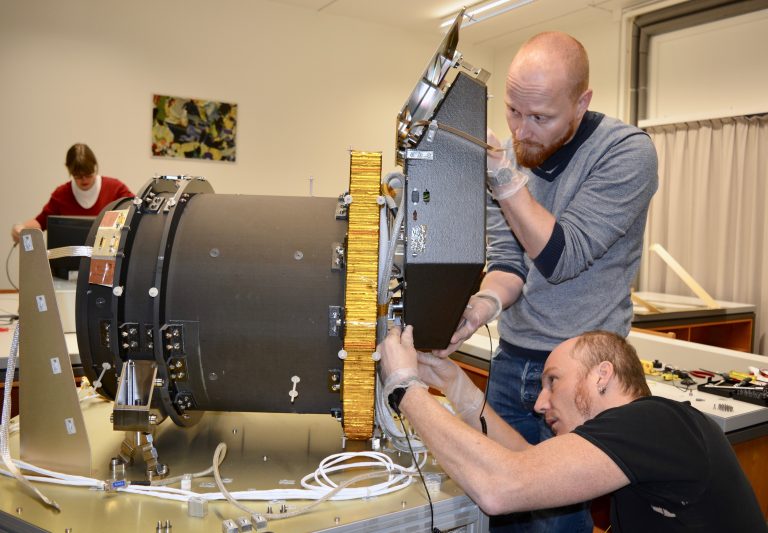Ready for testing electromagnetic compatibility
February 14th, 2017

At the University of Bern, the CHEOPS team integrated all electrical and electronic parts into a model of the space telescope to test whether the different units and wires operate correctly and don’t interfere with each other. The electromagnetic compatibility test will take place in the second half of February in a special chamber at a Swiss centre in Regensdorf, ZH. [fusion_builder_container hundred_percent="yes" overflow="visible"][fusion_builder_row][fusion_builder_column type="1_1" background_position="left top" background_color="" border_size="" border_color="" border_style="solid" spacing="yes" background_image="" background_repeat="no-repeat" padding="" margin_top="0px" margin_bottom="0px" class="" id="" animation_type="" animation_speed="0.3" animation_direction="left" hide_on_mobile="no" center_content="no" min_height="none"][caption id="attachment_7942" align="alignright" width="768"] At the University of Bern, Martin-Diego Busch and Sacha Häusler prepare the Electrical Qualification Model for testing electromagnetic compatibility. (Photos Barbara Vonarburg)[/caption] The non-descript black box attached below the telescope to what will be the spacecraft's side panel is the instrument main computer and power converter. Called Back End Electronics, short BEE, it is the main interface to the spacecraft in terms of power and data transmission. It comprises the power unit that will convert the voltage provided by the spacecraft to the levels needed by the telescope as well as the main instrument computer that will analyse the CHEOPS images in real time and provide information for accurate control of the spacecraft pointing. The BEE is also responsible for maintaining a constant temperature of the telescope tube by powering heaters inside the tube. Although the heaters are already installed in the tube of the telescope, the engineers built a separate heater unit that operates in the same way and allows a quick testing of the software before the official procedure. This radiator sits on the floor but is connected to the BEE with the same kind of wires as will be used in the real spacecraft. «Although it is only a test version, this on-board computer could almost be used for the real satellite», explains CHEOPS instrument manager Annette Jäckel. It was built by IWF (Institut für Weltraumforschung) in Graz, Austria, in collaboration with RUAG AT, and handed over to the team in Bern in January. «Now we are responsible for its proper functioning», says Annette Jäckel. [/fusion_builder_column][fusion_builder_column type="1_1" background_position="left top" background_color="" border_size="" border_color="" border_style="solid" spacing="yes" background_image="" background_repeat="no-repeat" padding="" margin_top="0px" margin_bottom="0px" class="" id="" animation_type="" animation_speed="0.3" animation_direction="left" hide_on_mobile="no" center_content="no" min_height="none"][caption id="attachment_7945" align="alignright" width="768"][
At the University of Bern, Martin-Diego Busch and Sacha Häusler prepare the Electrical Qualification Model for testing electromagnetic compatibility. (Photos Barbara Vonarburg)[/caption] The non-descript black box attached below the telescope to what will be the spacecraft's side panel is the instrument main computer and power converter. Called Back End Electronics, short BEE, it is the main interface to the spacecraft in terms of power and data transmission. It comprises the power unit that will convert the voltage provided by the spacecraft to the levels needed by the telescope as well as the main instrument computer that will analyse the CHEOPS images in real time and provide information for accurate control of the spacecraft pointing. The BEE is also responsible for maintaining a constant temperature of the telescope tube by powering heaters inside the tube. Although the heaters are already installed in the tube of the telescope, the engineers built a separate heater unit that operates in the same way and allows a quick testing of the software before the official procedure. This radiator sits on the floor but is connected to the BEE with the same kind of wires as will be used in the real spacecraft. «Although it is only a test version, this on-board computer could almost be used for the real satellite», explains CHEOPS instrument manager Annette Jäckel. It was built by IWF (Institut für Weltraumforschung) in Graz, Austria, in collaboration with RUAG AT, and handed over to the team in Bern in January. «Now we are responsible for its proper functioning», says Annette Jäckel. [/fusion_builder_column][fusion_builder_column type="1_1" background_position="left top" background_color="" border_size="" border_color="" border_style="solid" spacing="yes" background_image="" background_repeat="no-repeat" padding="" margin_top="0px" margin_bottom="0px" class="" id="" animation_type="" animation_speed="0.3" animation_direction="left" hide_on_mobile="no" center_content="no" min_height="none"][caption id="attachment_7945" align="alignright" width="768"][ ]2 Luca Malvasio has a look at the Back End Electronics.[/caption]
]2 Luca Malvasio has a look at the Back End Electronics.[/caption]